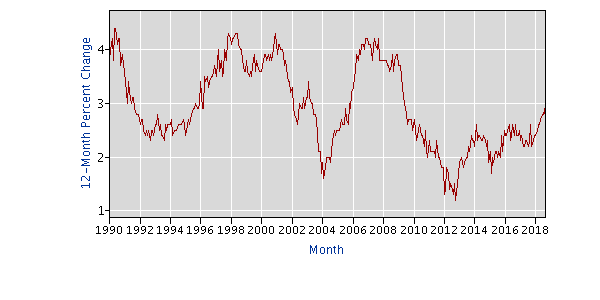October 23, 2018
Ernie Tedeschi has a very useful piece in the NYT Upshot section noting that wage growth is still far below its 1990s boom pace, even though unemployment is actually slightly lower. He notes that the slowdown is pretty much across the board, hitting all demographic groups and industries and occupations. This rules out stories that seek to explain this slowdown as a result of some group of workers lacking the right skills.
He notes three plausible stories that could explain weaker wage growth. One is that the labor market still does not look as tight as the late 1990s if we look at employment rates of prime-age workers (ages 25 to 54) instead of unemployment rates. This reflects people dropping out of the labor force who may still want to work.
The second is weaker productivity growth. Productivity increased at close to a 3.0 percent annual rate in the 1990s boom. In recent years, it has been just over 1.0 percent. It is worth noting that a tight labor market could itself lead to more productivity growth as employers feel more need to economize on labor. We did see strong productivity growth in the second quarter and are likely to see another strong quarter in the third quarter, but these numbers are erratic, so we can’t celebrate just yet.
The third point is the weakening of workers bargaining power, first and foremost from a decline in unionization rates. The fact that the national minimum wage has not been increased for almost a decade would also be a factor.
There is one other point on this topic that is worth mentioning. As Joe Gagnon has pointed out, if we look at acceleration rather than rates of growth, the current period does not look that different than the 1990s boom. In the 1990s, year-over-year wage growth bottomed out at 2.3 percent in 1993, they peaked at 4.3 percent in 1997 and at several subsequent points. This is an increase of 2.0 percentage points, as seen below.
Percentage Increase in Average Hourly Wage for Production and Non-Supervisory Workers
 Source: Bureau of Labor Statistics.
Source: Bureau of Labor Statistics.
By comparison, year-over-year wage growth bottomed out at 1.2 percent in 2012. It peaked at 2.9 percent in August, an increase of 1.7 percentage points. That is still less than the 2.0 percentage point increase in the rate of wage growth in the nineties boom, but not very much less.
It is also worth noting that the annualized rate of growth comparing the last three months (July, August, September) with the prior three months (April, May, June) is 3.3 percent. This measure is erratic, but I would be willing to bet on some modest acceleration, which will make the increase in wage growth in the current period almost identical to the rise in the 1990s. None of this should make workers feel great, there is still lots ground to make up from the Great Recession, but we may be moving in the right direction.







Comments